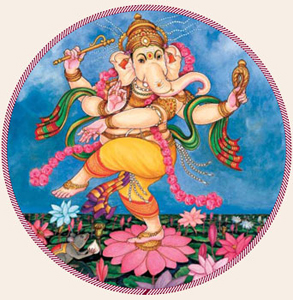
The Benefits of Befriending Ganesha
 e sincerely hope that this chapter will serve to bring you closer to Lord Ganesha. We are deeply grateful to Gurudeva for his inspiring words of wisdom, drawn from his book, Loving Ganesha, which fill the following 13 pages. One comment that he makes especially stands out to me as central: “Among all the wonderful Hindu Deities, Lord Ganesha is the closest to the material plane of consciousness, most easily contacted and most able to assist us in our day-to-day life and concerns.” In giving this some thought, I developed a list of eleven ways in which Ganesha can benefit your everyday life. These benefits were written for youth, as that is the best time to develop a closeness with Ganesha, but they apply equally to adults.§
e sincerely hope that this chapter will serve to bring you closer to Lord Ganesha. We are deeply grateful to Gurudeva for his inspiring words of wisdom, drawn from his book, Loving Ganesha, which fill the following 13 pages. One comment that he makes especially stands out to me as central: “Among all the wonderful Hindu Deities, Lord Ganesha is the closest to the material plane of consciousness, most easily contacted and most able to assist us in our day-to-day life and concerns.” In giving this some thought, I developed a list of eleven ways in which Ganesha can benefit your everyday life. These benefits were written for youth, as that is the best time to develop a closeness with Ganesha, but they apply equally to adults.§
 strengthen memory
strengthen memory  stimulate intelligence
stimulate intelligence solve problems easier
solve problems easier  study well in school
study well in school  stabilize emotions
stabilize emotions  improve your character
improve your character  experience good timing
experience good timing  increase domestic harmony
increase domestic harmony  increase self control
increase self control remove obstacles in your path
remove obstacles in your path be more successful in life §
be more successful in life §
Through the worship of Lord Ganesha, we feel better about life, rising above the lower emotions of insecurity, fear, anger and jealousy and instead experiencing peace and contentment. Tuning in to His shakti and being, through attending puja at the temple or even just visualizing Him in your mind, helps raise you up into the muladhara chakra and therefore out of anger and fear into a calm state of mind. In fact, you can slowly seal off these lower states of mind and keep awareness permanently lifted above the animal instincts of fear and anger through the regular worship of Lord Ganesha. He sits on the chakra of memory; and when we are stable in that chakra, focused and concentrated, our memory is strong and our intellect keen.§
Lord Ganesha’s worship can enable us to tune in to the natural flow of events that allows us to be in the right place at the right time. Have you noticed that some days our timing is excellent and yet other days everyone we go to see has just left, the store just closed, we missed our bus by one minute? The worship of Ganesha quiets the aggressive intellect, allowing you to be guided by intuition, which can change a day of bad timing to one of perfectly good timing. Everyone knows Lord Ganesha is the Lord of Obstacles, able to both place a barrier in our path when our direction is less than perfect and to remove barriers that keep us from achieving our highest aspirations in life. By bringing our consciousness close to Him, we give permission for Him to positively influence our life in these subtle, often unseen, ways. §
When you start each day’s study, or come upon a difficult subject, pray for Ganesha’s clear mind. See and feel a bright yellow light around your head. Feel smart. Strongly desire to understand. When you have a problem in life, at school, home or work, Lord Ganesha will help you. Ganesha knows everything about you and everybody you know, from the past into the future. But you must ask for His help. See Ganesha’s majestic face and with mental force ask for help and explain the problem. Lord Ganesha will send you ideas and thought power, introduce you to new attitudes, help you to understand other people, help you use wisdom and not emotions to face life’s many experiences, and when that happens you will be more successful in all you undertake. §
It is very clear that worshiping Lord Ganesha can benefit our life in many ways, provided we have developed a closeness with Him to the point where He is our friend. Ganesha is then able to help us become happier, more successful and more cultured Hindus who value the temple as an indispensable part of our life. §
Knowing that the Gods are real beings and that the purpose of going to the temple is to experience their blessings is what transforms the temple from a cultural hall to a truly sacred place. §
For the full, online version of Loving Ganesha, go to
www.himalayanacademy.com/resources/books/lg/§
 he great Lord Ganesha has been prayed to, worshiped and adored in one form or another since time began; and time itself began with His creation. He, above all others, is the God, the great Mahadeva, to be invoked before every act and especially worshiped and prayed to when changes occur in our lives as we move from the old established patterns into new ones. Lord Ganesha is always there to steady our minds and open the proper doors as we evolve and progress. He never, ever fails. He is always there for us when we need Him.§
he great Lord Ganesha has been prayed to, worshiped and adored in one form or another since time began; and time itself began with His creation. He, above all others, is the God, the great Mahadeva, to be invoked before every act and especially worshiped and prayed to when changes occur in our lives as we move from the old established patterns into new ones. Lord Ganesha is always there to steady our minds and open the proper doors as we evolve and progress. He never, ever fails. He is always there for us when we need Him.§
Hindus around the world pray to Ganesha for help and guidance as He leads us out of an agricultural age through the technological and information eras and on into the new age of space. Many are still on the farms; others are in the offices and in the factories; while still others land on the moon and orbit through space. With a mind more intricate than the most complicated computers in the world all hooked together, but as simple as an on-and-off switch, Ganesha knows all aspects of these transitions, in unfailing continuity, from one era to another. He is totally aware, at every point in time, of the mother in her home, the farmer in his field, the astronaut orbiting this planet, the corporate worker at his desk and the factory technician performing his tasks.§
For thousands of years in the villages of Vedic India, Lord Ganesha has been and is today in towns and cities in many countries, a powerful and immediate presence in everyone’s lives. He was and is the one prayed to when starting a business or an enterprise of any kind. Today factory workers approach a small shrine dedicated to Him before commencing their daily work, so that nothing might go wrong. Businessmen beg His help in adjusting the stock market to their advantage, and farmers, of course, chant His 108 names while planting their seeds, rice, other crops, or trees. When no rain comes, images of our loving Lord are seen throughout Bharat land submerged in water up to His neck, so that His great mind may become impressed with the people’s crying needs. When Grandma is sick or the crops are not coming in on time, when the children are growing up wrongly by adopting alien ways, Hindus diligently pray to our loving God for help in restructuring their lives. He is the supreme Lord of Dharma, and we pray to Him for guidance in the direction of our lives.§
Worship of Lord Ganesha is immediate. One has but to think of His form to contact His ever-present mind. Close your eyes for a second, visualize His large elephant head and experience the direct communication that has immediately begun. This is similar to punching in a code at a personal computer terminal which gives immediate access to the entire network of computers, large and small. On this remarkable and universal Innernet, obscure and necessary information and answers to every question are now available as needed through the direct link with Lord Ganesha. Wherever we are, whatever we are doing, we can use the computer terminal of our own brain and code in the divine image of Lord Ganesha and gain complete access to His vast computer-like mind. Ganesha’s mind has been programmed by the history of experience over eons of time and naturally encompasses the intricacies of the universe and the cycles of life in all their ramifications and simplicities. Our great God Ganesha sits contentedly upon the muladhara chakra. This chakra controls the forces of memory within every creature. Worship of Him strengthens your memory, builds character and brings knowledge from the within. It also protects you from the lower forces which reside in the little-known chakras below the muladhara. These darker chakras govern fear, anger, jealousy and the confused thinking centered around self-preservation.§
Adopted by the Elephant God
 eekers of Truth come from many backgrounds, many religions, and have trod many paths. Having become acquainted with Lord Ganesha, they may wonder how their past can participate in their present aspirations. “What am I doing worshiping an elephant-faced God and loving it?” they may wonder. “What do I do now to harmonize this unfoldment with my previous upbringing?”§
eekers of Truth come from many backgrounds, many religions, and have trod many paths. Having become acquainted with Lord Ganesha, they may wonder how their past can participate in their present aspirations. “What am I doing worshiping an elephant-faced God and loving it?” they may wonder. “What do I do now to harmonize this unfoldment with my previous upbringing?”§
There is a way to reconcile this subconscious dilemma. Let’s not “pack it away in denial,” as they say; let’s face up to the spiritual awakening. Truth is, you have a loving friend in Ganesha, who, if we may use the word, is the pope of the Hindu religion. And you are by no means alone. One fourth of the human race is acquainted with Ganesha—twenty-five percent of the people on this planet—1.25 billion, and that number is growing year by year.§
Our loving Ganesha leads his devotees deep into the oldest religion on planet Earth. There are two ways to come into Hinduism. One is to be born into the Hindu religion and be carried in your mother’s arms to the temple, there to be inwardly and psychically connected to our loving God, Ganesha. So strong are those early impressions and samskaras that they carry you through life. Another way is to unfold naturally to the point of being ready to formally enter Hinduism, to supplicate, to sincerely entreat the guardians of that religion to allow you to be a part of that immense and ancient tradition. You have to want to be a Hindu so strongly, so sincerely, that Lord Ganesha lifts you out of the fog of the materialistic conscious mind, establishing a connection and a relationship with you. This is a personal relationship with the Deity. There is nobody in-between—just you and the God, Lord Ganesha. It’s like being adopted, in a way. If you were an orphan or abandoned on the streets of São Paulo or Chennai or on the streets of wherever there are little kids running around, you would be “free.” You could go through life listening to no one and exercising unrestricted free will, free instinctive will. If you had a developed intellect, then you could exercise an intellectual will. You could do anything that you wanted to do, absolutely anything. Of course, you would find that as you attempted to fulfill your desires, you were limited, sometimes prevented, by the natural forces within and without. But you could attempt anything. §
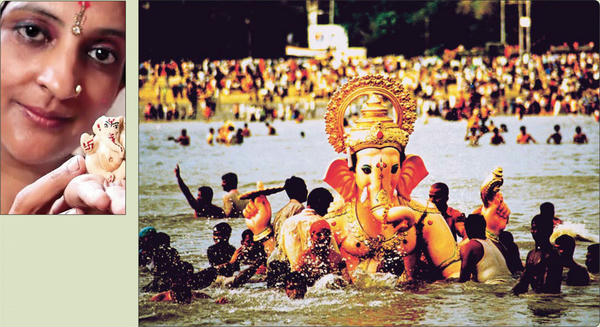
Devotees immerse a large image of Ganesha during His grand departure festival in Mumbai. A devotee shows off the clay Ganesha she has made for the festival.§
If you were fortunate enough, foster parents might come along to help you. They would adopt you and take you into their home. Your new mother would begin to lovingly guide and direct your life. You are a part of their family now, and your well-being, your education, your training all now come under their will, to which you must adjust yourself and obey. They will watch over you and discipline you morning and night. They will protect you from getting into trouble with your “free will.” The modern concept of freedom leads to the darker chakras below the muladhara chakra. Anguish is there.§
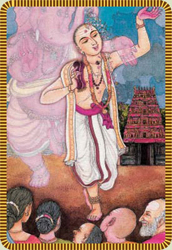
A man dances in ecstatic devotion as Ganesha hovers nearby in His subtle body.§
It is the same when you evolve a relationship, a personal relationship, with the Deity Lord Ganesha. He will not allow you to use your free will to get into difficulties. Guiding you carefully and protecting you along your way in your natural karma through life is His concern. Someone once said, “I worship Lord Siva. I worship Lord Murugan, but I have never really gotten acquainted with Lord Ganesha.” I responded, “You worship Siva and Lord Murugan, and that is wonderful. But unless you have established a personal relationship with Lord Ganesha, your worship of any of the Gods is probably more according to your own thoughts and fancy than true worship. Until you have established a rapport with Lord Ganesha, you cannot establish a relationship with Krishna, Ayyappan, Amman, Vishnu, Rama, Hanuman, Lakshmi, Sita, Radharani, Siva or Murugan, outside of your own limited concepts. It is Ganesha who introduces you to the millions of Gods of the Hindu pantheon, no one else. That is the way it works.” Yes, little by little, slowly, imperceptibly, a relationship evolves, a very personal, loving relationship, between the devotee and the elephant-faced God. Psychic protection is granted; physical protection, mental and emotional protection are all granted as boons by Him. He will not allow His devotees to use their free, instinctive willfulness to make more negative karma by getting into difficulties. Rather, He will guide them carefully, protecting them every moment along the way so that their natural birth karmas may be worked through and good karma created by right living. This is His main concern. Lord Ganesha loves and cares for His devotees. Once the devotee is connected to Him through the awakening of the muladhara chakra, loneliness is never experienced.§
Ganesha is a truly wonderful, loving God. He has an extraordinary knack for unweaving complicated situations and making them simple. He can unweave His devotees from their karma, simplifying and purifying their lives. But this only happens after they have established a personal relationship with Him. Soon thereafter, changes begin to happen in their lives; and when they go through difficult times, they no longer become angry or live in fear or worry. When difficult times come, they know it is because they are being unwound from accumulated and congested, difficult karmas, or being turned in a new direction altogether. They know that at such a time they have to consciously surrender their free, instinctive willfulness and not fight the divine happenings, but allow the God’s divine will to guide their life. Such is the spiritual path of total surrender, known as prapatti.§
Wherever His devotees are—in the home, the factories, the offices, the hospitals, the marketplace, orbiting in space or tilling the soil on the farm—Lord Ganesha is ever there. Intimate access is acquired by simply loving Ganesha and holding His robust image in your mind. Carefully visualize the large head and ears, His long trunk, massive body, big belly and the objects He holds in His many hands. Look into Ganesha’s eyes. Train yourself to see Him within your own mind with your eyes closed. This is the key. Hold His form steady in your mind through the power of visualization. Now you can talk to Him. Pronounce the words mentally into His ear. He is listening, though He will never speak back but take into His vast mind your prayer and slowly work it out. You must simply speak all of your questions and your problems into His right ear. When you are finished, open your eyes. Go on with your day and go on with your life. Wherever you are, remember this simple way of making contact with Lord Ganesha and as a good seeker exercise this psychic power, this siddhi.§
Starting today and in the days to come, you will notice how He answers questions and solves problems for you through the course of your daily life. You will notice how He influences events and decisions slowly and subtly, in unseen ways. Situations will change for you, unexpected doors will open, and accustomed ones will close as you are propelled through His grace toward your inevitable glorious future. Read and reread the above formula for immediate access to Lord Ganesha until it is firmly implanted in your subconscious memory patterns, and then begin to make contact with Him often through each day wherever you are and whatever you are doing. Yes! Lord Ganesha is immediate, and you have immediate access to Him. Wherever you are, remember this and as a seeker on the path through life’s experiences exercise this siddhi. It is your right to do so.§
Once a psychic connection is made with Lord Ganesha—the Deity who manifests in several forms, including the elephant-headed Lord of Categories and Remover of Obstacles—one is brought slowly into the mysteries of the Sanatana Dharma. Such an inner connection, which can be as subtle as a feeling, as tenuous as a dream or as bold as a personal visit, is also an entering into one’s own muladhara chakra, governed by the planet Mercury, for every opening into a new chakra is also an introduction to the Deity who governs that state of consciousness and the planet to which that chakra is connected.§
The Sanatana Dharma, known today as Hinduism, is the only living religion on the planet that does not look to a human founder for its source of inspiration, scripture or historical beginning. It is timeless and ageless. Sanatana Dharma, the root religion of humankind, looks inward for its origins, into the subtle, superconscious realms within the microcosm, which it calls the Karanaloka, Sivaloka or Third World. This great religion has no single organized headquarters on the material plane. Nor does it have a one hierarchy. Who then is in charge of Hinduism? Why, it is none other than our loving Ganesha! He doesn’t live in Rome, nor in Salt Lake City. Lord Ganesha lives simultaneously everywhere Hindus worship and pray within themselves. He doesn’t have to be reappointed from time to time, because yugas and yugas ago He was permanently and irrevocably appointed when He was created for this work. §
Ganesha, the Gatekeeper§
Yes, it is the Great Ganesha who is the gateway for seekers into the world’s most ancient faith. He is the inner authority, the guardian, the one who grants access to the spiritual mysteries of the Sanatana Dharma. All Hindus worship Him, regardless of their sectarian or philosophical positions. He truly binds them together in His love. This great God is both the beginning of the Hindu religion and the meeting ground for all its devotees. And that is only proper, inasmuch as Ganesha is the personification of the material universe. The universe in all of its varied and various magnificent manifestations is nothing but the body of this cheerfully portly God.§
Ganesha sits on the psychic lotus of the muladhara chakra, the ganglia of nerves at the base of the spine within everyone. This chakra governs time, matter and memory. As the spiritual aspirant is lifted up from fear and confusion into conscious awareness of right thought, right speech and right action, the muladhara chakra becomes activated. It is then that the seeker, with heart filled with love, encounters the holy feet of Lord Ganesha. As the spiritual seeker worships the loving elephant-faced God, clearness of mind comes more and more as he automatically and very slowly enters the Hindu path to enlightenment. Once the connection is firmly established between the devotee and Ganesha, all of the currents of the devotee’s mind and body become harmonized. After that strong connection is made, should he falter on the spiritual path, he has gained divine protection.§
But the seeker loses one thing. He loses his free, instinctive willfulness. It is lost forever. Yet it is not a great loss. Man’s own personal willfulness, his animalistic free will, is a feeble and insignificant force when compared to Lord Ganesha’s divine will. When beholden to God Ganesha and inwardly awakened enough to be attuned to His will, it is then quite natural that the instinctive will bows down. Personal likes and dislikes vanish. Limited faculties of reason and analysis are overpowered and subdued by a greater will, a cosmic will, the will of dharma. When sufficient humility has been awakened, it is easy to surrender personal, instinctive willfulness to the greater subsuperconscious will of dharma. It happens most naturally, but very slowly, because Lord Ganesha, of all the many Gods, proceeds with methodic deliberation. He is the careful, loving guide on the inner path of all seekers.§
Among all the wonderful Hindu Deities, Lord Ganesha is the closest to the material plane of consciousness, most easily contacted and most able to assist us in our day-to-day life and concerns. In His hands Ganesha wields a noose and a goad. With the noose He can hold you close or hold obstacles close. Ganesha can capture and confine both blessings and obstacles. With the goad, Ganesha can strike and repel obstacles. This Lord is called the Remover of Obstacles; but He also places obstacles in our way, for sometimes his devotees are proceeding in the wrong direction, and His obstacles block their progress and guide them slowly back onto the straight path of dharma. When instinctive willfulness causes the seeker to decide to step out of the boundaries of dharma, the Lord of Obstacles is there to block the way. His emblem is the swastika, symbolizing His circuitous course in guiding the seeker through life’s perplexing experiences.§
The Meaning of Grace§
“What about the grace of the Deity?” seekers ask. Grace is received from the God when you are consistent in your worship, consistent in your discipline, consistent in your bhakti, your devotion. With such a foundation in your life, a great shakti, a force or power, will come from Lord Ganesha. This is grace. It is uplifting. It comes unexpectedly. When grace comes, your mind may change and your heart may melt. Your sight will become clear and penetrating. You may say, “I have been graced to see everything differently.” New doors will begin to open for you, and as you go through them, your life will become more full, more wonderful. And the grace of it is that it would not have ordinarily happened to you.§
By grace we are directed deeper into spiritual life, pointed in the right direction, carefully guided on the San Marga, the straight path to our supreme God. After grace has been received, our thoughts are enlivened, our life is inspired with enthusiasm and energy, and we live daily in the joyous knowledge that everything is all right, everything is happening around us in accord with our karma, our dharma and God’s gracious will.§
The Milk-Drinking Miracle of 1995
 t all began on September 21, 1995, when an otherwise ordinary man in New Delhi dreamt that Ganesha, the elephant-headed God of wisdom, craved a little milk. Upon awakening, he rushed in the dark before dawn to the nearest temple, where a skeptical priest allowed him to proffer a spoonful of milk to the small stone image. Both watched in astonishment as it disappeared, magically consumed by the God. Within hours, news spread like a brush fire across India that Ganesha was accepting milk offerings. Tens of millions of people of all ages flocked to the temples. The unworldly happening brought worldly New Delhi to a standstill, and its vast stocks of milk, more than a million liters, sold out within hours. Just as suddenly as it started in India, it stopped, in just 24 hours. But it was just beginning elsewhere, as Hindus in India called their relatives in other parts of the world. Soon our HINDUISM TODAY offices were flooded with reports from around the world. Everywhere the story was the same. A teaspoonful of milk offered by touching it to Ganesha’s trunk, tusk or mouth would disappear in a few seconds to a few minutes—not always, but with unprecedented frequency. Reuters news service quoted Anila Premji, “I held the spoon out level, and it just disappeared. To me it was just a miracle. It gave me a sense of feeling that there is a God, a sense of Spirit on this Earth.” Not only Ganesha, but Siva, Parvati, Nandi and the Naga, Siva’s snake, took milk. This “milk miracle” may go down in history as the most important event shared by Hindus this century, if not in the last millennium. It has brought about an instantaneous religious revival among nearly one billion people. No other religion has ever done that before! It is as if every Hindu who had, say, “ten pounds of devotion,” suddenly has twenty.§
t all began on September 21, 1995, when an otherwise ordinary man in New Delhi dreamt that Ganesha, the elephant-headed God of wisdom, craved a little milk. Upon awakening, he rushed in the dark before dawn to the nearest temple, where a skeptical priest allowed him to proffer a spoonful of milk to the small stone image. Both watched in astonishment as it disappeared, magically consumed by the God. Within hours, news spread like a brush fire across India that Ganesha was accepting milk offerings. Tens of millions of people of all ages flocked to the temples. The unworldly happening brought worldly New Delhi to a standstill, and its vast stocks of milk, more than a million liters, sold out within hours. Just as suddenly as it started in India, it stopped, in just 24 hours. But it was just beginning elsewhere, as Hindus in India called their relatives in other parts of the world. Soon our HINDUISM TODAY offices were flooded with reports from around the world. Everywhere the story was the same. A teaspoonful of milk offered by touching it to Ganesha’s trunk, tusk or mouth would disappear in a few seconds to a few minutes—not always, but with unprecedented frequency. Reuters news service quoted Anila Premji, “I held the spoon out level, and it just disappeared. To me it was just a miracle. It gave me a sense of feeling that there is a God, a sense of Spirit on this Earth.” Not only Ganesha, but Siva, Parvati, Nandi and the Naga, Siva’s snake, took milk. This “milk miracle” may go down in history as the most important event shared by Hindus this century, if not in the last millennium. It has brought about an instantaneous religious revival among nearly one billion people. No other religion has ever done that before! It is as if every Hindu who had, say, “ten pounds of devotion,” suddenly has twenty.§
Miracles witnessed by many people happen from time to time in Hinduism as in other faiths, but they’re rare. As a young boy, the tenth-century saint, Nambi Anbar Nambi, inspired Lord Ganesha to actually eat the offerings placed before Him. Saint Jnaneshvara of Maharashtra became famous 600 years ago for having a water buffalo recite the Vedas before a group of arrogant priests.§
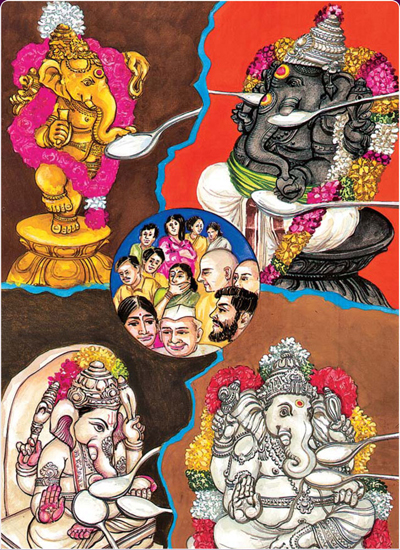
 Artist’s depiction of the milk miracle: devotees lined up in long cues and took turns offering spoons full of milk to statues of Ganesha, small and large, around the world. Magically, the milk would vanish as if being sipped by an invisible being.§
Artist’s depiction of the milk miracle: devotees lined up in long cues and took turns offering spoons full of milk to statues of Ganesha, small and large, around the world. Magically, the milk would vanish as if being sipped by an invisible being.§
Naturally there are skeptics—10 percent of Hindus, according to our very unscientific poll, all of whom moved swiftly to distance themselves from the phenomenon. “Capillary action,” coupled with “mass hysteria,” is the correct explanation, concluded many scientists within a few hours. Aparna Chattopadhyay of New Delhi replied to these scoffers in a letter to the Hindustan Times: “I am a senior scientist of the Indian Agriculture Research Institute, New Delhi. I found my offerings of milk in a temple being mysteriously drunk by the Deities. How can the scientists explain the copper snake absorbing the milk I offered with a spoon kept at a good distance away from it?” Scientific or not, gallons of milk were disappearing with hardly a trace. A leading barrister in Malaysia was dumbfounded when he watched a metal Ganesha attached to an automobile dashboard absorb six teaspoons of milk. In Nepal King Birendra himself made offerings to the God. Deities in Kenya and other countries took gallons of milk while sitting in shallow metal trays with no drains.§
The worldwide press coverage was nearly as amazing as the miracle itself. Of course, the event dominated the news in India for days. But once it started outside India, local and leading national papers, such as the New York Times and Washington Post in America, and the Financial Times in UK, picked up the story. The international wire services, Reuters and Associated Press, carried a dozen articles a day on what had now been named the “Milk Miracle.” Many in India are unaware of how warmly the Western press embraced the miracle. In many countries reporters came to the temples and personally offered milk. §

The Gods Are Real Beings, Not Mere Symbols§
Many people look at the Gods as mere symbols, representations of forces or mind areas. Actually, the Gods are beings, and down through the ages ordinary men and women, great saints and sages, prophets and mystics in all cultures have inwardly seen, heard and been profoundly influenced by these superconscious, inner-plane, inner-galactic beings. Lord Ganesha is just such a being. He can think just as we can think. He can see and understand and make decisions—decisions so vast in their implications and complexity that we could never comprehend them with our human faculties of limited understanding.§
In recent history, missionaries and others from the Western religions have told the Indian people over and over again that their Gods are not real beings, but merely symbols of spiritual matters—and unfortunately many have begun to believe this and look at their Gods in this way. Even among Hindus there are quite a few who don’t believe in inner-world beings. Their belief is restricted to the people they see in the physical world, and that is all. You dare not tell them differently. It is very difficult, but not impossible, to introduce them to the grand philosophy which is based solely on worship, meditation, inner discipline and the search for Absolute Truth. But this is too high-minded for those living in the everyday materialistic consciousness. For the knowledge of inner worlds to become accepted, a personal realization has to occur. This is a slow process for the materialist, a very slow process, and only Lord Ganesha can help it along. To contact Lord Ganesha, it is imperative that the materialist visit one of His temples or shrines, to make initial contact. It only takes one meeting.§

A gallery of Ganesha images, from greeting cards, posters and temples§
Around the World§
 aha Ganapati, of course, belongs to all mankind, not to Hindus alone. To the Chinese He is embodied in the form of a massive dragon, whose physical immensity depicts His incredible and irresistible force. To some Chinese He is Kuan-shi t’ien or Ho Tei, the large-bellied God of Happiness. To the Polynesians in Hawaii He is God Lono.§
aha Ganapati, of course, belongs to all mankind, not to Hindus alone. To the Chinese He is embodied in the form of a massive dragon, whose physical immensity depicts His incredible and irresistible force. To some Chinese He is Kuan-shi t’ien or Ho Tei, the large-bellied God of Happiness. To the Polynesians in Hawaii He is God Lono.§
The South Indian and Sri Lankan Tamils call him by the affectionate term Pillaiyar, “Noble Child.” The Tibetans know Him as Ts’ogsbdag, and the Burmese worship Maha-Pienne. In Mongolia His name is Totkharour Khaghan. Cambodians offer worship to Prah Kenes, and the Japanese supplicate Vinayaksa or Sho-ten. By some He is envisioned as the feminine Mother Nature, and even nonbelievers seek to understand Him through personifying His great powers as Fate, Destiny or Numen. The ancient Egyptians may have known Him as a minor but very popular Deity, Bes, grotesque, pot-bellied and cheerful. The Romans called Him Janus and sought His blessings at the outset of any new venture. On His festival on the first of January (the month named after Him) He was treated with special cakes; mutual good wishes were exchanged and people made presents of sweets to one another for a good omen for the new year. In the West He is ubiquitous as the corpulent jolly Santa Claus, the dispenser of boons and gifts, especially to children, who knows our thoughts, words and deeds and bestows rewards accordingly. The Buddhists and Jains also honor Ganesha. In one form or another, He is honored throughout the world.§
Hindus worship the great God Ganesha at countless pujas performed daily on every continent. In temples and home shrines Lord Ganesha is worshiped today in India, Sri Lanka, Nepal, Malaysia, Java, Bali, Borneo, Tibet, Myanmar, Siam, Afganistan, the Middle East, China, Indo-China, Japan, the Caribbean, Trinidad and Tobago, Hawaii and the Pacific Islands, Africa, Mauritius, Reunion, Europe, Australia, Canada, South America, the United States and elsewhere.§
Mantras to Ganesha—Using the Magic of Sound
 apa, or recitation, is the spiritual practice of devotedly repeating a mantra, generally a specified number of times, such as 108, often while counting on a strand of beads, called a japa mala, while conscientiously concentrating on the meaning of the mantra. The repetition should be dutifully slow. This brings punya, merit, to the devotee. It should not be thoughtlessly mechanical or hurried, the so-called rapid-fire or machine-gun japa. Such casual, nonchalant negligence and disregard for contemplative traditions brings papa, demerit, to the devotee, creating internal strife, community opposition and turmoil for all concerned. §
apa, or recitation, is the spiritual practice of devotedly repeating a mantra, generally a specified number of times, such as 108, often while counting on a strand of beads, called a japa mala, while conscientiously concentrating on the meaning of the mantra. The repetition should be dutifully slow. This brings punya, merit, to the devotee. It should not be thoughtlessly mechanical or hurried, the so-called rapid-fire or machine-gun japa. Such casual, nonchalant negligence and disregard for contemplative traditions brings papa, demerit, to the devotee, creating internal strife, community opposition and turmoil for all concerned. §
Japa is a form of devotional worship, invocation, supplication, praise, adoration, meditation and direct, experiential communion. Unless we are actually in a state of samadhi (total absorption), which is rare for most people, japa provides a means to disengage from our racing thoughts and our memories of the past—mostly the bad ones. The repetition of positive, uplifting, spiritual mantras over and over again lifts consciousness and causes the muladhara chakra to spin clockwise. We feel uplifted. Life does not look so bad, and neither does the past. A sense of forgiveness comes and the future looms bright. The past is forgiven and forgotten.§
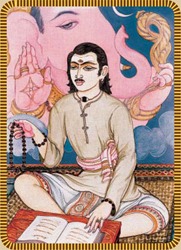
A devotee performs japa.§
What is important for us to realize is that each Mahadeva can be experienced, expressed, in a mantra form that corresponds to that Being. This phenomenon is akin to remembering someone by his name rather than his face. When we utter such a mantra, we call forth the Mahadeva or cause a particular inner truth to rise up in our minds. Then we feel His presence and enjoy.§
Repeating mantras slowly purifies the mind, like running fresh water continually into a container of discolored water. A fresh stream of water causes the mud at the bottom of a container to rise and flow out over the top edges, eventually to be completely replaced by crystal-clear water. Similarly, japa cleanses the mind of impurities as the pure vibrations of the mantras loosen and wash away the impure vibrations.§
Lord Ganesha is invoked through the mantra Aum. The Mandukya Upanishad elucidates the inner meaning of Aum, which embodies the highest wisdom. Aum has three syllables. A represents the waking state. U represents the dreaming state. M represents the state of deep sleep. Aum in its entirety, plus the moment of silence which follows it, represents the shanti, the peace beyond understanding. Thus, Aum japa performed as an invocation to Lord Ganesha, the Lord of Wisdom and Knowledge—while love is welling up from our hearts and tears are for no reason flowing simultaneously—calls forth the knowledge of the entirety of our existence in these four categories of consciousness. These are realms that God Ganesha rules over as Lord of Categories, and this is the knowledge that He can grant devotees who perform Aum japa and meditation on the meaning of Aum.§
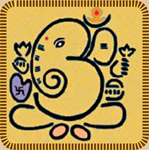
Ganesha in the Aum§
For Aum japa to be effective, the mantra must be pronounced correctly. The first syllable is A, pronounced as the English word “awe,” but prolonged: “aaa.” The second syllable is U, as in “roof,” pronounced “oo” but prolonged: “ooo.” The third syllable is M, pronounced “mm” with the front teeth gently touching and the sound prolonged: “mmmm.” Each repetition is sounded for about seven seconds, with two seconds on A, two seconds on U and three seconds on M, with a silence of about two seconds before the next repetition. The three syllables are run together: AAUUMM (silence), AAUUMM (silence), AAUUMM (silence). On the first syllable, A, we feel the solar plexus and chest vibrating. On the second syllable, U, the throat vibrates. The third syllable, M, vibrates the top of the head. Thus, proper chanting of Aum is a high form of yoga, moving energy from the lower chakras of the body up to the highest chakra, or energy center—the sahasrara chakra at the crown of the head.§
Another traditional way to do this japa is to take a full breath and then chant the AUM three times as you exhale. The first repetition is audible, the second is more quiet and the third is barely audible, as you concentrate within. Then inhale slowly as you visualize the image of our loving Lord Ganesha in your mind. Then repeat the AUM again three times as you exhale. The breathing should not be forced, but natural, slow, gentle and rhythmical. We can use a japa mala with 108 beads and pass over one bead for each repetition, or do the japa for a prearranged period of time.§
Two other Ganesha mantras are commonly used. One is Aum Shri Ganeshaya Namah, meaning “Praise to Lord Ganesha.” This is the mantra of invocation, adoration and worship. It is repeated at the beginning of pujas, and it can be used for japa to invoke Ganesha’s blessings for the auspicious beginning of a task, project, change of life, community undertaking or simply to offer Him our praise. Another special mantra is Aum Gam Ganapataye Namah. This is Lord Ganesha’s mula (“root”) mantra. It is also known as His bija mantra, for it combines Ganesha’s bija (“seed”) sound, Gam, with the phrase, “Praise be to Ganapati.” This mantra is used for yoga sadhana in which we invoke Ganesha and merge ourself with His supreme knowledge and peace. §
When the ganas and devas of Lord Ganesha are finally attracted to the home shrine, the room will feel filled with spiritual energy. This feeling indicates that Ganesha’s ganas are present, eager and willing to do whatever they can to maintain shanti, peace, within the home and bind the family together.§
Every Hindu village and community has an image of the God Ganesha, and one of the many forms of Ganesha is found in every Hindu temple. The eminent scholar M. Arunachalam wrote, “Ganesha is usually installed at the entrance to the central sanctum, at the south, and also at the southwestern corner in the first court, of every Siva temple. Besides, He is placed on the first eastern goshta (niche) on the other southern wall of the ardha mandapa (secondary hall) in the dancing pose, known as Nartana Ganapati, in many temples. The tip of His trunk will curve to the left and touch the modaka, generally held in the left hand. In a few rare cases the trunk will curve to the right to touch the modaka on a right hand. Here He is called Valampuri (right turned) Vinayaga” (Festivals of Tamil Nadu, 1980, p. 112).§
While Ganesha shrines are found at all Hindu temples, they often stand alone as well. They are often quite humble, not uncommonly a simple roadside shrine such as the one between Jaffna and Anuradhapura in Sri Lanka or along the roadsides here and there in South India. Here travelers stop to break a coconut and burn a bit of camphor before the Lord of Obstacles to pray for a safe and successful journey. There is a similar shrine near the university in Chennai. Many years ago a young man discovered a tree that formed the shape of Ganesha’s head in its gnarled trunk. He began worshiping and soon took a vow not to leave the site. Travelers and students about to take their exams come to the shrine to seek Lord Ganesha’s blessings. Such tree shrines enjoy the patronage of thousands of worshipers annually.§
Historically His image is often found in places of danger, such as steep slopes, river crossings or where two roads cross. Here His murti may be a rough-hewn stone or even a trunk of a bo or banyan tree which has taken the form of the God Ganesha. A natural stone, or svayambhu (“self-created”) murti, may also be the object of worship. Researcher Alice Getty wrote: “The most celebrated svayambhu murtis of Ganesha are found in Kashmir, where there are three famous and most powerful formless stones which from ancient times have drawn pilgrims to their shrines. One, which is near the village of Ganesh-bal, is in the river Lidar near its right bank, and is still an important place of pilgrimage.... Another rock in Kashmir which has been worshiped from most ancient times as a symbol of Ganesha under the name of Bhimasvamin is at the foot of the hill Hari-Parbat near Srinagar.... The most remarkable of these svayambhu murtis in Kashmir is the one on a cliff along the Kishen-Ganga known as Ganesh-Gati” (Ganesha, a Monograph on the Elephant-Faced God, by Alice Getty, 1971, p. 22-23).§
Perhaps the most famous Ganesha temple in India is the Uchi Pillaiyar Koyil at Trichy. Uchi means “at the top.” This large temple (also known as the Rock Fort Temple), built on a hilltop, commands a breathtaking view of the city and of the river Kaveri. Another large Ganesha temple is the Pillaiyarpatti Temple near Karaikudi in Ramanathapuram District, also in Tamil Nadu. In New Delhi there is the Siddhi Buddhi Vinayagar temple situated in Vinayanagar. The Mukkuruni Pillaiyar inside the huge Meenakshi Temple complex in Madurai, India, is also quite famous. This murti is ten to twelve feet tall. Mukkuruni refers to a large measure of rice (about forty pounds). Here the priests cook a huge modaka ball for Ganesha using this measure. Hence the name Mukkuruni Pillaiyar. Also in Madurai, Lord Ganesha is worshiped as Vyaghrapada Ganeshani, in female form with tiger feet. The Ganeshani murti in sukhasana pose resides at Suchindram. There are two other temples in India with the female Ganesha form. One is at a tenth-century temple dedicated to sixty-four yoginis in Bheraghat, a village near Jabalpur. The other is the Tanumalaya Swami Temple in Suchindrum, Kerala. In Tibet She is worshiped as Gajanani.§
A five-headed Ganesha mounted on a lion resides at Nagapattinam. At Vellore, India, Ganesha is enshrined as Valampuri Vinayakar, with his trunk turned to the right instead of to the left. This murti is considered very auspicious. Highly revered Ganesha shrines are also found in the Siva temple of Tirunelveli, in the Kanyakumari temple at the southern tip of India, and in Rameshvaram and Chidambaram. Our loving Ganesha is especially beloved in Maharashtra, where eight temples form one of His most sacred pilgrimages, and dozens of other sites are designated for his adoration. (Go to www.gurudeva.org/resources/books/lg/lg_ch-13 for an extensive list of prominent Ganesha citadels.) It is said that to make a visit on hardship pilgrimage (third-class on trains, on foot or by crawling) to 108 Ganesha temples and roadside shrines is most auspicious to smooth out the karmas of the future by dissolving, through His grace, the negative karmas and mistakes of the past, made knowingly or unknowingly. Penance of this sort deliberately condenses into a short period, or puts all in one place, the suffering that would otherwise be encountered over a long span of time.§
The garden island of Sri Lanka has fourteen well-known Ganesha temples. There is an unusual Vinayaka at the Siva temple in Central Java, which is presently an archeological tourist site being restored by the Indonesian government. Lord Ganesha here sits with the soles of His feet pressed together, much like a child would sit, or as a yogi might sit in deep samadhi.§
Festivals for Ganesha 
 pulent Hindu festivals are times of joyous celebration marked by special observances. There are many festivals each year, several to each of the Gods. Festivals are characterized by acts of piety—penance, fasting, sadhana, pilgrimage—and spiritual rejoicing: singing, dancing, musical performance, parades, feasting, storytelling, scripture-reading and elaborate pujas. Here we briefly present the major festivals that honor Lord Ganesha. §
pulent Hindu festivals are times of joyous celebration marked by special observances. There are many festivals each year, several to each of the Gods. Festivals are characterized by acts of piety—penance, fasting, sadhana, pilgrimage—and spiritual rejoicing: singing, dancing, musical performance, parades, feasting, storytelling, scripture-reading and elaborate pujas. Here we briefly present the major festivals that honor Lord Ganesha. §
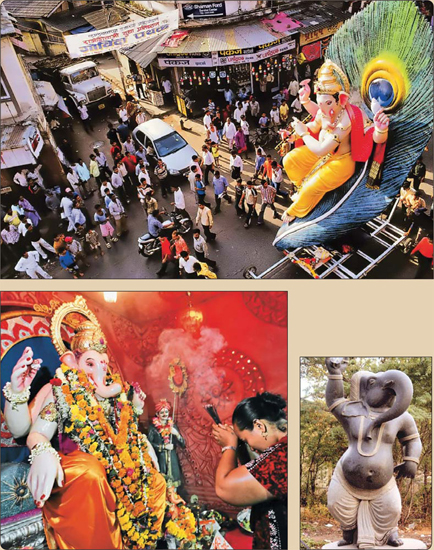
A parade in Mumbai; A devotee prays intently and offers incense; A graceful Ganesha in granite carved in Bangalore§
Ganesha Chaturthi§
Ganesha Chaturthi, also known as Vinayaka Chaturthi, is the festival day celebrating the birth of Lord Ganesha. One of the great national festivals of India, and the foremost annual festival to Ganesha, it is celebrated on the chaturthi, or “fourth day” after the new moon, in August/September. We decorate the temple and home shrine with banana leaves, sugarcane and strings of mango leaves, making it look like a small forest. We bring baskets of fruits and sweets, especially modaka balls, and place them before the sanctum. He receives special pujas throughout the day and often a festival parade. Each year we obtain or make a small or large soft clay image of Ganapati and use it for worship at home for two to ten days after Ganesha Chaturthi. Then we bid Him fond farewell, honoring His departure, or visarjana, with a grand parade, as we carry Him to the water’s edge on a palanquin bedecked with flowers and accompanied by puja, music, dancing and celebration. Clay images of Ganesha specifically prepared for the event are ceremoniously dissolved in the ocean or other body of water at this time by devotees all over the world, signifying His withdrawal into all-pervasive consciousness. This final day is known as Ganesha Visarjana.§
Vinayaka Vratam§
Vinayaka Vratam is a 21-day festival honoring Lord Ganesha beginning on the full moon day in the month of Karttikai—November/December. During these days, Vinayaka Purana, or stories, are recited in the temples, and special pujas are conducted at every Ganesha temple. Many devotees observe the vrata (vow) of attending daily puja at a Ganesha temple and taking only one meal a day, in the evening.§
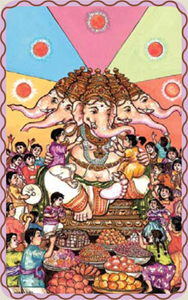
Children bring offerings during Pancha Ganapati. The five colored rays above Ganesha represent his five shaktis.§
Pancha Ganapati§
Pancha Ganapati is a modern festival of the Five-Faced (pancha means “five”) Ganesha held in Hindu homes from December 21 through 25. Pancha Ganapati is a Hindu expression of this natural season of worship, gift-giving and celebration. A festive shrine is created especially for the five-day event in the main living room of the home. Each day sweets, fruits and incense are offered to Pancha Ganapati, ideally prepared and presented by the children. Puja is performed and hymns and bhajanas are sung in His praise. Each day gifts are given to the children, who place them unopened before Pancha Ganapati, to open on the fifth day.§
On each day the family focuses on one of Ganesha’s five shaktis, through discussion, gift-giving, apology and appreciation. On day one we draw forth Ganesha’s first shakti to create a vibration of love and harmony among immediate family members. On day two we draw forth Ganesha’s second shakti to establish a vibration of love and harmony among neighbors, relatives and close friends. On day three we strive to create love and harmony among business associates, the casual merchant and the public at large. On day four we draw forth the vibration of joy and harmony that comes from music, art, drama and the dance. On day five we strive to bring forth the special rewards and fulfillments that only religion brings into our life. We focus this day on our connection with Ganesha, the Lord of Dharma, by holding five special pujas for Him through the day. After the grand evening puja, gifts are distributed and joyously opened. Happy children. Happy parents. Happy God.§
Shri H. Krishnamurthi writes in Tattvaloka (Feb.-March 1990): “Several images of Ganesha have been discovered in the excavations of Central America and Mexico. It is said that in Mexico the name of Ganesha is Virakosha.” India’s Birla Science Institute announced a new find: “A piece of evidence was connected with the legend of Ganesha’s writing down the [Mahabharata] epic to the dictation of Vyasa. A metal plate depicting the elephant-headed Deity holding an etching stylus has been found in Luristan in Western Iran and has been dated to around 1200 BCE (Motilal Banarsidass Newsletter Dec. 1993).”§
Among the most renowned of Ganesha’s temples in Malaysia are the Siddhi Vinayagar temple of Petaling Jaya and the Kotta Malai Pillaiyar Temple of Kuala Lumpur on the busy street of Paduraya. The latter is a small temple, but extremely powerful, said to be the most popular Ganesha temple in the land. Also notable are the Jalan Pudu (Pasar Road) Pillaiyar Temple and the Poyyata Vinayagar Temple of Melaka. In Hawaii our Kadavul Hindu Temple has a three-ton, six-foot-tall Ganesha. At the Saiva Dharmashala at Riviere du Rempart, Mauritius, we have dedicated a Spiritual Park and erected a grand pavilion around a five-ton, nine-foot tall, five-faced murti of Ganesha, Panchamukha Ganapati, in a mango grove. In Edmonton, Canada, New Zealand and Nandi, Fiji, Seattle, Salt Lake City, Bethesda, Denver, Scottsdale, Sebastian, Anchorage and Chicago there are exquisite stone murtis of the elephant-faced God, gifted by my aadheenam to the born Hindu communities, conferring blessings for new temples. In Great Britain Ganesha is enshrined at each of the nation’s several new temples, including the Shree Ganapati Temple in Wimbledon, and is the presiding Deity at the and at temples in Switzerland, Germany and Denmark. §
The religion of the earliest known North American Indians bears many analogies to and apparently has sprung up from the same ultimate sources as our own venerable Sanatana Dharma, a fact that is evidenced by their rituals and religious beliefs and symbols. One of Lord Ganesha’s oldest symbols, the swastika, was one of the central motifs used in the designs and patterns of many American Indian tribes and is still seen today in their beautiful blankets and pottery. So the great God Ganesha is not really new to the Western countries, but quite old. His recent coming into prominence is more our remembering Him in lands where He has always been. But it is in this twentieth century, in the decades of the 70s and 80s, that Lord Ganesha came to be traditionally enshrined in magnificent multi-million-dollar Hindu temples. We find Him in New York, Pittsburgh, Chicago, Concord, Livermore, Fremont, Denver, Houston, Nashville, Edmonton in Canada and hundreds of other places. These shrines have brought forth the murti, or physical image, of Ganesha as Gajanana, the Elephant-Faced. Ganesha’s presence in North America at the beginning of the growth of Agamic Hinduism in the West ensures its success.§
As Hinduism emerged in North America in the twentieth century, Ganesha led the way. One of the first traditional temples to be built was the large Maha Ganapati Temple in Flushing, New York. As each community sought guidance and direction in establishing religious roots, I constantly urged the trustees of each temple society, who came seeking guidance from Kauai’s Hindu Monastery in the Hawaiian Island chain, to first begin their congregations in the worship of Ganesha in order for their temple to come up quickly. §
We would often present the group with large or small stone image of the great God and give them the blessings for His worship to begin. Thus, at many a new temple site, a Ganesha image was established in a small shrine while construction and fund raising proceeded. This occurred in Fiji, Edmonton, Livermore, Fremont, Salt Lake City, Houston, Denver, Chicago, Lansing, Bethesda, London, Germany and elsewhere. Priests were brought from India, devotees flocked to the shrines, the worship began, and the funds to construct the temple began to flow. This practice has now become a tradition in the West as Hindus have learned from experience that once Lord Ganesha is worshiped, it is actually He who builds the temple in a most wonderful and inspiring way, and they are His helpers.§
Connecting with Ganesha through Puja
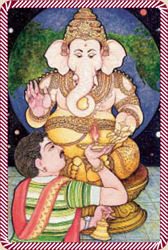
A devotee performing puja perceives Ganesha as a real, living being.§
 ove and joy come to Hindu families who worship Lord Ganesha in their home through the traditional ceremony known as puja. By means of such sacred rites and the divine energies invoked, each family makes their house a sacred sanctuary, a refuge from the concerns and worries of the world. Pujas can be as simple as lighting a lamp and offering a flower at the Lord’s holy feet; or they can be elaborate and detailed, with many chants and offerings. The indispensable part of any puja is devotion. Without love in the heart, outer performance is of little value. But with true devotion, even simple gestures are sacred ritual. Every morning, all around our planet, millions of Hindus perform puja in their home. §
ove and joy come to Hindu families who worship Lord Ganesha in their home through the traditional ceremony known as puja. By means of such sacred rites and the divine energies invoked, each family makes their house a sacred sanctuary, a refuge from the concerns and worries of the world. Pujas can be as simple as lighting a lamp and offering a flower at the Lord’s holy feet; or they can be elaborate and detailed, with many chants and offerings. The indispensable part of any puja is devotion. Without love in the heart, outer performance is of little value. But with true devotion, even simple gestures are sacred ritual. Every morning, all around our planet, millions of Hindus perform puja in their home. §
A superb definition of puja is given in South Asian Folklore: An Encyclopedia. “A puja is a ritual performance that honors a being or an object and provides the context for the transaction between worshiper and deity in which a visual and substantive connection can occur. The most common expression in theistic Hinduism today, pujas are done outdoors, in homes, temples, at natural sites, and within a devotee’s mind and body. The external focus of a puja is a murti (form), which may be a respected living being, such as a teacher or guru; a stone, wood, or metal icon of a deity; an aniconic image, such as the Ganges River; plants; animals; the implements of one’s profession or subsistence; or any form to which devotion and a relationship of dependence is to be demonstrated” (Routledge, 2002).§
One need not be initiated to perform simple puja invoking our Loving Ganesha. All that is required is that the celebrant believe in the laws of karma and reincarnation, which are the cornerstones of Hindu ethical and philosophical doctrine. Ganesha worship is enjoyed by all, Hindus and non-Hindus alike, as He is the first God to be worshiped. It is not wise for an ardha-Hindu, or half Hindu, to centralize worship on Siva or Murugan or other Gods until full commitment has been made through receiving the traditional sacraments, called samskaras. Home puja is performed at least once a day, usually in the early morning. It is traditional to not partake of food at least three hours before puja, so puja is usually done prior to meals.§
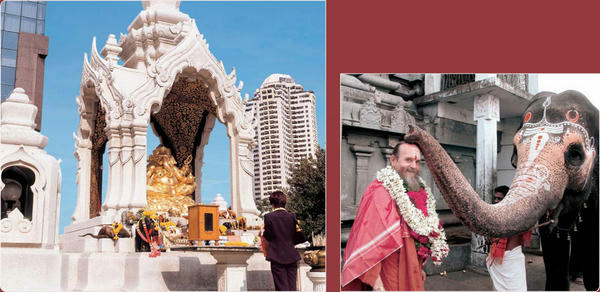
This stunningly ornate Ganesha shrine at Bangkok’s World Trade Center is a favorite place of worship for Thai Hindus and Buddhists. Bodhinatha receives an elephant’s blessing in Madurai. §
All Hindus attend puja at their local temple at least once a week and maintain a sacred shrine at home, which esoterically functions as an extension of the temple. The shrine room is meticulously cared for and not used for purposes other than worship, prayer, japa yoga, scriptural study and meditation. Here puja, home liturgy, is performed daily, generally by the head of the house. All members of the family attend.§
Creating a home shrine is not difficult. The altar should be close to the floor, since most of the puja is performed while seated, or when there are small children in the home it is often higher, out of their reach. For a Ganesha shrine, an image, or murti, of Lord Ganesha is placed at the center of the altar. §
The entire puja, of which this is a summary, can be learned in the following chapter. Puja is a ritual welcoming of a holy person or deity, to whom all precious substances and comforts are offered. Offerings are made with the right hand.§
The offering of food is an important part of puja, such as cooked rice or freshly cut fruit. After the puja, the food offerings—along with holy ash (vibhuti), sacred water (tirtha), sandalwood paste (chandana), red powder (kunkuma) and flowers (pushpa)—are passed out and enjoyed as prasada, for they have been imbued with the blessings of the God.§
After the sacraments are passed out, everyone present can chant Aum three times and then sit quietly and direct their worship to God within themselves. Externalized worship traditionally is followed by internalized worship, yogic quietude enjoyed in the aftermath of the puja. The simple practice of mentally chanting Aum followed by a period of meditation and self-reflection makes devotees strong enough to face the external world with enhanced willpower, true confidence and a heart filled with love, realizing that we are truly one world, one family.§
Visions of Ganesha§
 ord Ganesha’s vivified presence in the Western world has already culminated in many special visions of Him by both born and formally converted Hindus living in North and South America. In hopes of spiriting onward the worldwide fellowship of Hindus around the globe, a few such visions will be included here anonymously.§
ord Ganesha’s vivified presence in the Western world has already culminated in many special visions of Him by both born and formally converted Hindus living in North and South America. In hopes of spiriting onward the worldwide fellowship of Hindus around the globe, a few such visions will be included here anonymously.§
Lord Ganesha has been worshiped here and there in North and South America in many small ways by devotees from India for many years since the turn of the century. But not until events in the early 1970s brought about the building of a large Ganesha temple in New York did Lord Ganesha take up a formal public residence. The sequence of events affirmed the ancient tradition wherein the Deity Himself decides when and where His temple is to be built. It is not a man or a woman or a group of people who make that decision on personal inspiration. Rather, the Deity, the God, informs us that the time has come for His temple to come up and then we, in turn, proceed to help Him manifest it in the material world. The message from the God containing the direction of when and where to build His home is traditionally given by Him to holy men, gurus, swamis or sants who are respected by the community and are in personal touch with the Gods. Such religious leaders also have spiritual insight into the religious progress of the community. Lord Ganesha may strengthen the instructions of such holy men through a dream or vision to a devotee.§
The Maha Ganapati Temple in Flushing, New York, began with two gentlemen from India who had been living in New York for several years. One of these hailed from a long line of temple builders; the other was a devout man who performed regular religious and yoga sadhana. This man had returned to India. He had a vision one night. He found himself soaring high above New York City until he came above an abandoned church in an area near his former residence. He came over the steeple, which opened as he moved down to land in front of the altar. Lo! There on the altar was Lord Ganapati Himself, who said nothing to him but just smiled. Immediately upon awakening, with his heart filled with love and the vision of the Great God still fresh in his inner mind, this sant phoned the temple builder who was then serving at the United Nations in New York. §
The temple builder asked him to come to New York right away. Travel arrangements were made, and within 24 hours the two of them were driving around the Queens section of New York in search of Lord Ganapati’s new home. They finally came upon the old church that was the very one seen in the vision and which was for sale at the time! There could be no doubt that Ganesha had shown where to put His temple. The building was subsequently purchased. After many years of hard work, with the blessings and sanction of Shrilashri Pandrimalaiswami, Ganesha was installed and consecrated in an orthodox shrine to receive traditional public worship.§
Since 1972 many other devotees have seen Lord Ganesha in their visions and dreams. For example, several pilgrims on the 1981 India Odyssey, a spiritual pilgrimage to the holy lands of ancient Bharat (India), had life-altering visions of Lord Ganesha at the Shri Kumbalavalai Temple in Jaffna, Sri Lanka. Such visions of Lord Ganesha clarify much about the way this great Lord works. While the visions took place within the subtle minds of His devotees, or our microcosm, this subtle space is in fact enormous and quite a macrocosm of its own.§
Just as Lord Ganesha’s vehicle, the tiny rodent, ferrets out every secret space and hidden area of the house, so does this Great Mahadeva have the ability to move within the seemingly most obscure and intricate areas of our minds. He is the master of both the big and the small, the macrocosm and the microcosm. Lord Ganesha’s great girth is the entire manifestation of all that is, of the five elements of earth, air, fire, water and ether. Thus, He pervades all, not from the outside in but from the inside out. He does not move to pervade, for all form in its purest state is together, not far apart. Seated unmoving on the broad, four-petalled lotus of the muladhara chakra, Lord Ganesha records and governs the movements of vast inner oceans of actinodic energy that appear to our physical eyes to manifest as forms so many millions of miles apart. He is at work through all the outwardly gross forms of nature, and yet mounted on his tiny mouse He can, in utter minuteness, travel about within His devotees’ minds as if they were great, well-lit caverns. Such is the mystery of the pompous elephant-faced God, the embodiment of form who rides the mouse.§
The final vision to recite is one that I had in the mid-1980s of Lord Ganesha walking from His temple attended by two priests. He was about to take a bath in the beautiful Indian Ocean in the country of Mauritius where the river meets the sea. I was standing in the water with several sharks swimming around me. Lord Ganesha, accompanied by two priests, looked at me and said, “Just rub some oil on their noses and they will not harm you.” This vivid mystic experience is illustrated on this page (above left).§
Remember, such visions of this great Lord do not come only to the meditating yogis, but to sincere bhaktas as well —those who by virtue of their good karma receive this special grace at particularly auspicious times in their lives.§
Personal Testimony about Ganesha
 Kamala Garneau, Edmonton, Canada. “During the last year of my degree, I was facing a very important interview for entrance into an internship program. As the interview drew near, I went to the temple and sat and prayed to Lord Ganesha. I told Him that I would make coming to see Him daily a priority in my life for a minimum of two weeks and as long as I could after that, and prayed for Him to remove any obstacles blocking my path from having a successful interview and being accepted into the program. The next day I woke up early and went to the temple for the puja. This routine continued, and the day of the interview drew near. On the day of the interview, I was reviewing some possible interview questions my family and I had prepared. Later, as I was brushing my teeth, three different interview questions just entered my mind. They were somewhat unusual and a little complicated to answer, so I mentally prepared answers to them as I drove to the interview. As it turned out, I was asked all three of those questions in exactly the same way they came to me. Thanks to Lord Ganesha, I had already prepared my answers and was easily able to handle them and finish the interview successfully. That night I went to the temple and thanked Lord Ganesha for helping me. A few months later I was accepted into the program.”§
Kamala Garneau, Edmonton, Canada. “During the last year of my degree, I was facing a very important interview for entrance into an internship program. As the interview drew near, I went to the temple and sat and prayed to Lord Ganesha. I told Him that I would make coming to see Him daily a priority in my life for a minimum of two weeks and as long as I could after that, and prayed for Him to remove any obstacles blocking my path from having a successful interview and being accepted into the program. The next day I woke up early and went to the temple for the puja. This routine continued, and the day of the interview drew near. On the day of the interview, I was reviewing some possible interview questions my family and I had prepared. Later, as I was brushing my teeth, three different interview questions just entered my mind. They were somewhat unusual and a little complicated to answer, so I mentally prepared answers to them as I drove to the interview. As it turned out, I was asked all three of those questions in exactly the same way they came to me. Thanks to Lord Ganesha, I had already prepared my answers and was easily able to handle them and finish the interview successfully. That night I went to the temple and thanked Lord Ganesha for helping me. A few months later I was accepted into the program.”§
 Sheela Venkatakrishnan, Chennai. “Ganeshas in myriad shapes and forms sit around my home, reminding me of who I am and what I can become! Tears wash away with just one look in the sheer joy that emanates from every form He took. Acceptance becomes a way of life. Surrender comes as a shield from strife. It becomes easy to amble along with the heart singing a sweet, sweet song! Ganesha, my friend, my guide, stands strong when all seems wrong. He lights up the way every day and shatters all that stands in the way of what I will become one day! A shining soul such as He. You are Him, and He is me!”§
Sheela Venkatakrishnan, Chennai. “Ganeshas in myriad shapes and forms sit around my home, reminding me of who I am and what I can become! Tears wash away with just one look in the sheer joy that emanates from every form He took. Acceptance becomes a way of life. Surrender comes as a shield from strife. It becomes easy to amble along with the heart singing a sweet, sweet song! Ganesha, my friend, my guide, stands strong when all seems wrong. He lights up the way every day and shatters all that stands in the way of what I will become one day! A shining soul such as He. You are Him, and He is me!”§
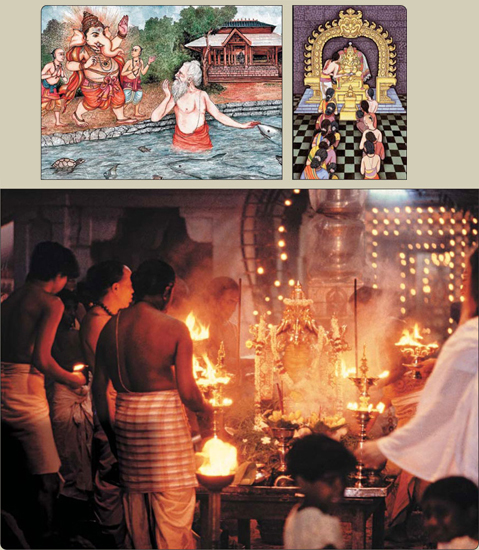
Gurudeva sees Lord Ganesha in a vision, who tells him to rub a little oil on the sharks’ noses; Devotees attend puja in a Ganesha temple; Priests raise the arati flame at the crescendo of puja to the five-faced elephant Deity at Kumbhalavalai Temple in Alaveddy, Sri Lanka.§
 Vikneswaran, Kuala Lumpur. “Since my teens, I have been acquainted with this beautiful God. He was my guide since then. I first got to know Him when I saw His svayambhu form in an old tree where people used to pray to Him. I would go and burn camphor to Him whenever I could. I wasn’t a devout person, and I was very much attached to the ideologies of the West. Still, my daily life somehow was centered around Him. I used to sit at the tree simply watching His beautifully formed face with its huge trunk. He somehow communicated with me whenever I was there with Him, and gradually my life turned more meaningful as I began to analyze what Sanatana Dharma is. I began to meditate, or rather sit down quietly to get some concentration. I began to buy books on spiritual life. Then one day, my group of friends brought me to a powerful consecration rite for a nearby Pillaiyar temple. During the visits to Pillaiyar in this temple my spiritual life deepened. I am still learning about Lord Ganesha, still communicating with Lord Ganesha, still loving my Lord Ganesha. Every single obstacle that I face in my life, Pillaiyar removes for me; even the littlest problems are solved by Him.”§
Vikneswaran, Kuala Lumpur. “Since my teens, I have been acquainted with this beautiful God. He was my guide since then. I first got to know Him when I saw His svayambhu form in an old tree where people used to pray to Him. I would go and burn camphor to Him whenever I could. I wasn’t a devout person, and I was very much attached to the ideologies of the West. Still, my daily life somehow was centered around Him. I used to sit at the tree simply watching His beautifully formed face with its huge trunk. He somehow communicated with me whenever I was there with Him, and gradually my life turned more meaningful as I began to analyze what Sanatana Dharma is. I began to meditate, or rather sit down quietly to get some concentration. I began to buy books on spiritual life. Then one day, my group of friends brought me to a powerful consecration rite for a nearby Pillaiyar temple. During the visits to Pillaiyar in this temple my spiritual life deepened. I am still learning about Lord Ganesha, still communicating with Lord Ganesha, still loving my Lord Ganesha. Every single obstacle that I face in my life, Pillaiyar removes for me; even the littlest problems are solved by Him.”§
 Chamundi Sabanathan, California. “My most vivid experience with Lord Ganesha occurred at the old temple on Sacramento Street in San Francisco, not long after His murti was installed. I was seated at the back of the room, but suddenly had the experience of being at His feet, prostrating with overwhelming devotion.” §
Chamundi Sabanathan, California. “My most vivid experience with Lord Ganesha occurred at the old temple on Sacramento Street in San Francisco, not long after His murti was installed. I was seated at the back of the room, but suddenly had the experience of being at His feet, prostrating with overwhelming devotion.” §

